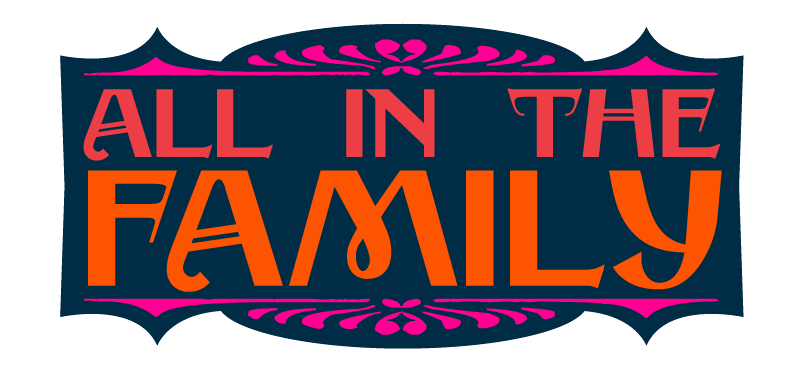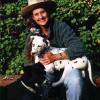
Rick Griffin: His Memory and His Art Live On — A Spring 1990 Profile
By Blair Jackson
It seems fitting that some of the last work the great San Francisco artist Rick Griffin did before his tragic death in a motorcycle accident in 1991 was connected to the good ol’ Grateful Dead. During 1990, he produced the front and back cover illustrations for the group’s 25th Anniversary Tour Book (reproduced in the Grateful Dead: Spring 1990 box set), plus posters and advertisements for the Dead’s fall ’90 European tour and the cover of the 2-CD live album that came out while they were in Europe, Without a Net.
By that time, Griffin had been friends with Dead for 25 years, having moved to San Francisco originally in 1966 and establishing himself as one of the “Big Five” psychedelic poster artists of the burgeoning Haight-Ashbury scene, along with Alton Kelley, Stanley Mouse, Wes Wilson and Victor Moscoso. Though only 22 when he moved to SF, Griffin had already carved a niche in his early teens as an artist in his native Southern California, creating a goofy surfer character named Murphy that became a fixture in Surfer magazine beginning in 1961. His designs also found their way onto surfboards, cars, T-shirts and decals.
During his short time as a student at the Chouinard Art Institute in L.A., he met his future wife, Ida Pfefferle (also and artist), and fell in with a group of proto-counterculture artists and musicians who called themselves the Jook Savages. Griffin first encountered the nascent San Francisco psychedelic rock world in the summer of ’65, when he saw The Charlatans during their residency as house band at Red Dog Saloon in Virginia City, Nevada. His first brush with members of the Dead most likely came at the infamous Watts (L.A.) Acid Test in March 1966, an event he later described as “Totally crazed.”
Like so many young, creative types in that era, Rick migrated to San Francisco in the autumn before the Summer of Love. As an artist, he was excited by the eye-popping posters for Fillmore and Avalon dances and other local events that Kelley, Mouse, Wilson, Moscoso and others were churning out, and it didn’t take long for him to get into the act himself: In late ’66 he collaborated with Kelley and Mouse on a poster for a benefit concert at Winterland. Then he designed one celebrating the first anniversary of the opening of the Psychedelic Shop in Haight-Ashbury, followed by a stunning pen-and-ink poster for the Human Be-In, depicting a Native American on horseback holding an electric guitar. Those works caught the eye of the Avalon/Family Dog’s Chet Helms, who asked Griffin to join his stable of poster artists.
His first Avalon posters combined his wonderfully imaginative letter-work with already existing images, such as Michaelangelo’s Adam from the Sistine Chapel, or the “Three Indian Dudes” from a 19th century photo who grace his first Grateful Dead poster. As the months passed, however, his own drawings increasingly found their way into his posters and they became more and more detailed, colorful and psychedelic. In February ’68 he designed his first Fillmore poster for Bill Graham Presents—the iconic “flying eyeball” advertising Jimi Hendrix shows at the Fillmore. A few others followed in the fall, but BGP was never a primary outlet for him.
“Doing posters on a regular basis was like going to my own art school,” Rick said in an interview in ZigZag magazine (and quoted in Paul Grushkin’s magnificent Art of Rock book). “My first pieces were in black and white, but pretty soon I started experimenting with color. I was figuring out the process as I went along, first in two colors, then in three, then in four. I was educating myself in the basic principles involved in printing color, how to mix colors, how to gear the overlays, how to work up the tones, and ultimately how to predict what the final version would look like.”
Griffin’s art seemed to be everywhere in the late ’60s. He turned out posters for a wide variety of shows and events. He was all over Zap Comix. He designed the striking cover of Quicksilver Messenger Service’s debut album. A spectacular poster he designed for three Avalon Ballroom shows featuring the Grateful Dead in January ’68 was later appropriated by the Dead for the cover of their 1969 album, Aoxomoxoa—certainly among the greatest works to come out of San Francisco in that era. (I’m sure I wasn’t the only teenager in the late ’60s who spent hours trying—and failing—to copy Rick’s lettering for that album in our school notebooks.)
After Rick’s death, Garcia admiringly told Rolling Stone, “I spent a lot of time trying to recall some sense of the psychedelic maelstrom—trying to draw it, trying to describe it verbally, trying to play it musically. And I thought Rick got a big bite of it. He brought more of it back from that uncharted area of the mind than almost anyone I knew.”
A profound conversion to Christianity in the early ’70s changed the thematic direction of Griffin’s art, but did not affect his skill—many of his Biblically oriented works stand with his best psychedelic-era pieces. In 1973, he created his second Grateful Dead album cover, for Wake of the Flood. In ZigZag, Rick noted that his original inspiration for the cover came from the Old Testament Book of Revelations: “And the sea gave up the dead that were in it and death and Hell gave up the dead that were in them, and they were judged, every man according to their works.” The image he produced, however, was designed “to show an alternative to that. I wanted to juxtapose that Scripture with a loving image, an image of loving harvest.” Still there was that eerie skull cloud floating in the sky behind the main figure.
As the years went by, he continued to create posters and art pieces for concerts and non-music events. He used an Egyptian theme for a Dead poster commemorating the band’s 1984 Berkeley Community Theatre series, and his skeletoid parody of a famous Dutch Masters cigar ad, bearing the words “Peace on Earth,” was sent to everyone on the Dead Heads mailing list during the 1987 Christmas season.
What turned out to be Rick’s last major pieces for the Dead—the European tour art and Without a Net cover—display so many of the characteristics that made his art so special and evocative. The designs are take-offs of both old circus posters and the Wild West shows of Buffalo Bill. On the CD cover, a fire-eating woman stands atop a fierce-looking bucking bronco. Skeleton Indian warriors ride a lion and a tiger, while other skeletons walk a tightrope and fly on trapezes. In the foreground, a menacing (Koko-esque) cartoon clown sticks out his tongue and appears to poke himself in the eye. In the “Europe 1990” illustration on the back of the tour book, the tiger leaps out of the picture at us, a skeleton wearing a leopard pelt wrestles a bear, skeletons in top hats form a pyramid above three motorcycles, and for reasons unknown, a placid brontosaurus towers over the whole scene—perhaps because the Dead were considered dinosaurs?
Whatever the meaning, both pieces are a perfect mixture of weirdness and whimsy—so Grateful Dead and so Rick Griffin.


